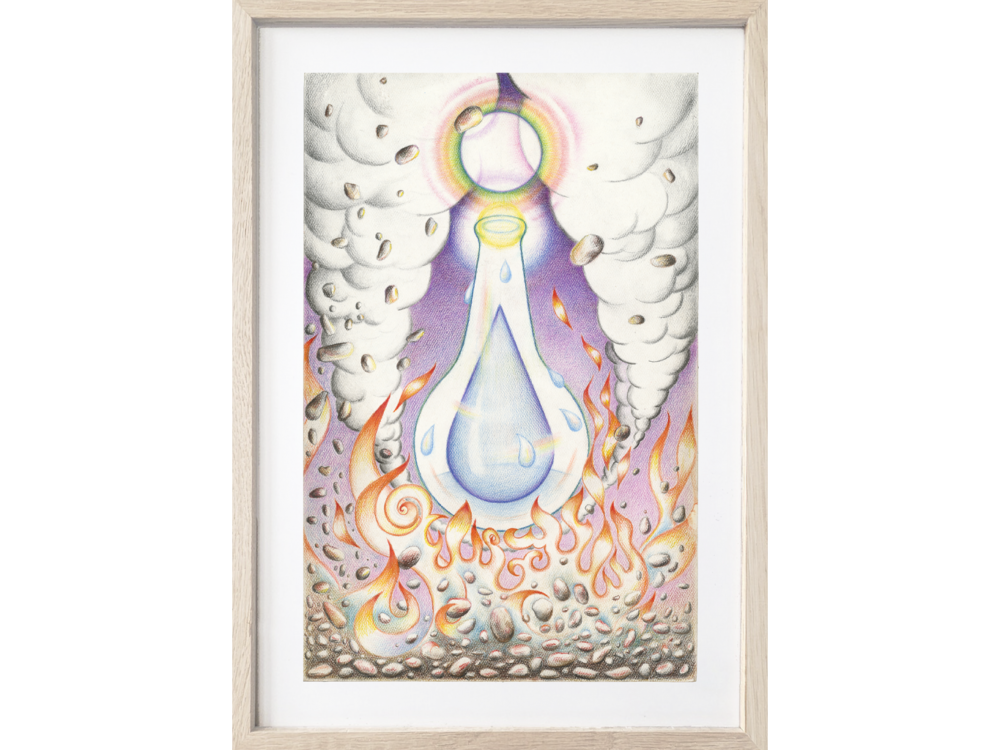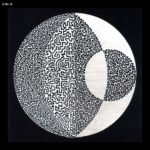Visual AIDS Artist Member Rafael Sánchez created Treatment Action Group's latest Limited Art Edition as part of a cycle of drawings that he began this past spring. TAG recently asked Rafael to share more about his work, his experience, and his inspiration. The following digital exchange is republished from TAG's newsletter.
More information about the TAG benefit on Monday November 14th and the Rafael Sanchez print can be found here.
What was your inspiration for Tintura del Sol?
Healing, life force, life work, transformation—nature’s work. The elements distilled and their constant movement—their integration into and through everything: celestial bodies, the combination of molecules, the formation of cells in our bodies…varying energies becoming one. It is the tincture of the sun: fire becomes water—earth’s fuel and the transmuting energy of air and its temperatures—it is the cycle of life and death. Everything is in constant becoming, disappearing, and becoming again. Holding that awareness at any given moment in the fleeting present is an ecstasy, like an orgasm of the soul.
In a sense, TAG caught Tintura del Sol as it was coming out of my hands. The piece is part of a cycle of drawings that began this past spring. I was recovering from open-heart surgery during a long hospital stay. The experience had me in an intense relationship with my body. And, as fate would have it, I lost three friends during my recovery: one a longtime AIDS survivor, another to suicide, and another died in their sleep from heart failure the day after visiting me. The nurses at the rehabilitation center gave me paper and a set of colored pencils. From there my recovery turned into a drawing residency resulting in a cycle of new work, including this drawing.
How does TAG's mission resonate with your work?
Interestingly, as TAG marks its 30th anniversary, this year also marks 20 years that I was diagnosed HIV+. In the fall of 2002, I became very ill soon after exposure. I was diagnosed early during seroconversion, which at the time was still relatively rare with HIV. I was fast tracked into a clinical study for protease inhibitor treatment during early infection. So, I was kind of a lab rat for about three years. The drugs were intense and I had several spinal taps. My body went through it but I learned a lot about what was going on with my body, our bodies, and what we were up against, scientifically…and socially, as I started my life in the world in my new body. I also sensed that it was a responsibility, and it was a form of quiet activism. I feel that way about care in general, to be honest. Caregivers and nurses hold this world together. This is profound and re-centering on many levels. Artists need to pay attention to this; it is a magnificent lesson to bring into the studio.
At the time, however, this was not a sentiment that the art world was easily embracing, not publicly anyway, even considering the impact HIV/AIDS had had upon it. I’ve come to understand that there was something of a collective need to distance from the trauma of the previous two decades. And the conversation around HIV/AIDS had been ostensibly eclipsed by the events of 9/11 and by the fall of 2002, but AIDS was certainly not over. In 2004, I partnered with artist Kathleen White. Because of her own creative journey and combined history of care and loss, she understood what I was going through, and she valued the presence of care in art and love.
As an artist living with HIV, how has the epidemic affected your life and your artistic work?
The impact of AIDS for me has been profound and visceral. From the onset of the epidemic, I have felt that we all have AIDS; it is something that impacts us all. The recent pandemic had the world shut down, but it was business as usual for most of the world during the worst of the AIDS epidemic. So, part of me wants to send this question back to everyone that’s been around since then to now. AIDS appeared into the world when I was in my early twenties as I was maturing as an artist into the world. Your question and certainly finding the vocabulary to answer it has been present since the beginning. Yet I’m not sure that I have found the vocabulary or the answer to it. And the stigma around AIDS has been so great, making most public conversation slippery and fraught.
On the other hand, my positive status has made me very sensitive to other marginalized voices. The writings of and commentary of James Baldwin, bell hooks, Leonard Peltier, Audre Lorde, and so many others resonate personally for HIV bodies. I was caring for sick friends, decades before I became HIV positive myself. On some level it has affected everything that I’ve made since 1981. How could it not? Before that I suppose it was the experience of being from somewhere else that prepared me for that. Art deals with the labyrinth of existence and our humanity. In professional life, we are encouraged to detach from our emotions…art provides an area where we can put things back together as they are falling apart. I don’t really know how else to put it without writing the book of many chapters.
What would you want our community to know most about you and your art?
I am blessed to have a life’s work that challenges and fills my spirit. It is the alchemical Rebis. It is the work of endless curiosity, self-realization, transformation; never finished or defined. To me, art is a guide, an elixir, medicine; an endless supply of alkaline batteries. It has saved my life over and over again. It is a light that comes from darkness. It emanates from childhood’s buried discoveries. It transforms pain, trauma, and grief into healing and joy. And it is through this joy that we find our brethren. My journey has been long, but every day I feel as though I am just starting. That’s a beautiful thing.
Treatment Action Group (TAG) is an independent, activist, and community-based research and policy think tank committed to racial, gender, and LGBTQ+ equity; social justice; and liberation, fighting to end HIV, tuberculosis (TB), and hepatitis C virus (HCV).

